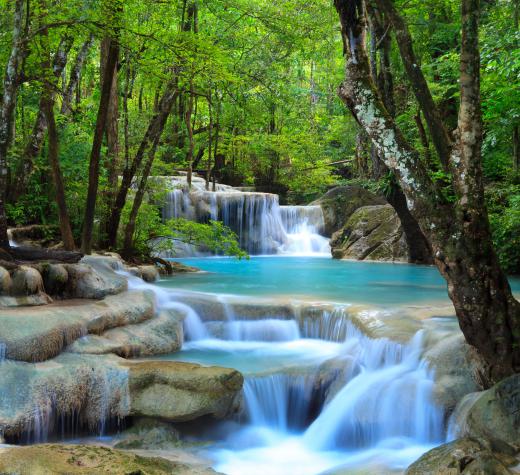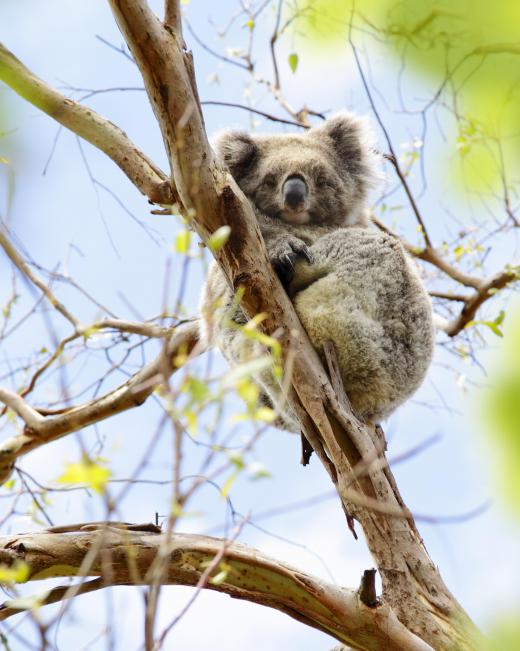What are Some Major Ecosystems?
 Michael Anissimov
Michael Anissimov
An ecosystem is a natural unit consisting of the abiotic (non-living) portion of an environment interacting with the biotic (living) plants and animals that are adapted to it. There are hundreds of ecosystems on the planet, divided into primary categories (i.e., desert) and numerous subcategories (i.e., Western Australia Desert). The major ecosystems on the planet are marine ecosystems, including the photic zone (within 200 m of the surface) and the abyssal plain (the ocean floors). The concept of an ecosystem is very similar to that of a biome.
The major ecosystems on the planet aside from aquatic ecosystems are the taiga (Canadian and Siberian coniferous forests), grasslands (covering most of Asia and North America), and the deep subterranean ecosystem, which extends 2-4 miles beneath the surface of the Earth and is primarily populated by bacteria. The latter is also known as the Subsurface Lithoautotrophic Microbial Ecosystem and is one of the least studied ecosystems on Earth, despite being one of the largest. Much of the planet can also be regarded as human-influenced ecosystems, as humans are so numerous and intervene in nature so frequently that few regions are untouched.

Ecosystems are often defined in terms of the primary producers (vegetation), which serve as the base of the ecosystem and which everything else eats, either directly (consumers) or indirectly (predators). In order of rough proximity to the equator, some major ecosystems defined by vegetation are tropical rainforest, subtropical rainforest, coniferous forest, grasslands, taiga, and tundra. These are intermixed with mountainous and desert ecosystems, each with their own unique flora and fauna. There are also a number of human major ecosystems, such as croplands and cities.

The most important terrestrial major ecosystem is rainforest – rainforests contain more than half of all biodiversity, maybe as much as 80%. Unfortunately, rainforests are also one of the fastest-disappearing ecosystems, destroyed by land clearing for agriculture. Unless this land clearing is aggressively halted, rainforests could disappear by 2100 or earlier.
AS FEATURED ON:
AS FEATURED ON:
















Discussion Comments
Someone once told me that mangrove ecosystems are very important because they are the link between the terrestrial and aquatic ecosystems. How do these ecosystems interact with ocean and terrestrial ecosystems?
@georgesplane- I saw a show recently about how the fishing industry in japan is being devastated by a certain type of giant jellyfish blooms. The jellyfish are blooming because of increased water temperatures and a lack of fish to eat the jellyfish in their plankton stage. The lack of fish is due to overfishing so it is a manmade problem that creates a positive feedback loop. The waters around japan are becoming an endangered ecosystem because the blooms used to happen only once every 40 years. Now they happen every year, and it is destroying sea life and the fishing industry.
The life cycle of these 400 pound jellyfish is amazing. The jellyfish each release a billion eggs upon spawning. When they are fertilized and settle on the ocean floor, they then split into hundreds more organisms. Once the conditions are right, the polyps each release tens more jellyfish. The narrator of the show said that a single jellyfish could theoretically spawn a trillion more jellyfish. It is no wonder they are overrunning the seas.
The primary producers in ocean ecosystems are phytoplankton. Without phytoplankton, the biodiversity in ocean ecosystems would be much less than it is today. If one thinks about how much area the oceans cover, the amount of biodiversity in the oceans, and the number of people dependent on the oceans biodiversity for survival, one could argue that phytoplankton is the most important primary producer in the world.
Lastly, I would also like to point out that phytoplankton is not one single organism. They are a collection of at least 5000 known organisms that are mostly photosynthetic in nature. Some phytoplanktons however are classified further as zooplankton, which are the "animal" like counterpart to the phytoplankton. Furthermore, the phytoplankton in the world’s oceans, seas, and lakes account for about half of the world’s photosynthetic activity.
Post your comments